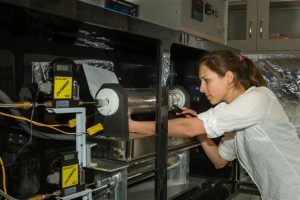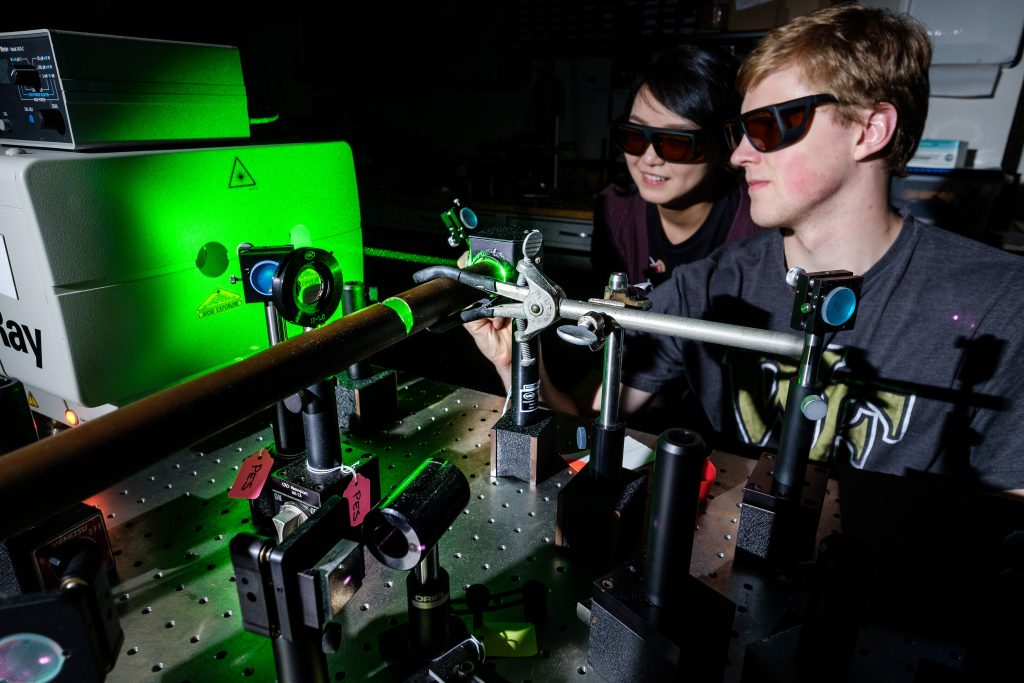Condensed Matter
Condensed Matter Physics
Professors Oana Jurchescu, David Carroll, and Ajay Ram Srimath Kandada, together with research professor K. Burak Üçer direct research in experimental condensed matter physics. Professors Stephen Winter, Timo Thonhauser, and Natalie A. W. Holzwarth, together with research professor William C. Kerr, direct research in computational condensed matter physics.
Experimental Efforts

The laboratory of Oana Jurchescu ![]() focuses on the study of charge transport in organic and halide perovskite electronic materials. Their efforts consist of several major lines of interest. They study single crystals of small molecule organic semiconductors to elucidate their intrinsic properties, establish the potential and limit of their use, and provide feedback for material and device design. They also investigate the interplay between chemical composition, crystal structure, and electronic properties in organic and halide perovskite semiconductors. A significant component of their effort is aimed at understanding the fundamental aspects of charge transport in these materials and how processing impacts the quality of various interfaces in devices.
focuses on the study of charge transport in organic and halide perovskite electronic materials. Their efforts consist of several major lines of interest. They study single crystals of small molecule organic semiconductors to elucidate their intrinsic properties, establish the potential and limit of their use, and provide feedback for material and device design. They also investigate the interplay between chemical composition, crystal structure, and electronic properties in organic and halide perovskite semiconductors. A significant component of their effort is aimed at understanding the fundamental aspects of charge transport in these materials and how processing impacts the quality of various interfaces in devices.
…
Computational Efforts
Steve Winter ![]() and his group concentrate on theoretical
and his group concentrate on theoretical
condensed matter physics in the area of Quantum Materials. These are systems where macroscopic quantum effects manifest in the material properties, with prominent examples including quantum magnets, superconductors, and topological insulators. We use a variety of theoretical approaches – including large numerical simulations and analytical (pen on paper) calculations – to try to model experiments on real materials, as well as classify and predict new quantum phases.

David Carroll’s group explores the fundamental roles that dimension, topology, and symmetry play in the emergent properties of low dimensional condensed matter systems and so called “quantum materials.” Recent Quantum computing research has focused on the development of massively parallel and neuromorphic architectures in Q-registers based on topologically stabilized Qbits. Other research in nano-systems includes Onsager entanglement in energy harvesting heat engines, Seebeck ion pumps and ionic Seebeck effects in 2D dichalcogenides and the search for new Topological Dirac or Weyl semimetals. Finally, the group is actively involved in fast laser studies to uncover new Floquet dynamics and spontaneous time-translation symmetry breaking in nonlinear solid-state systems: ie. new time crystals. This work is carried out at the Center for Nanotechnology and Molecular Materials ![]()
Emerging optoelectronic and photonic technologies rely on the control of photo-excitation dynamics in semiconducting materials. Kandada‘s group investigates the chemical and physical factors that govern these dynamics in a wide class of materials through advanced optical spectroscopic techniques. The experimental toolbox is composed of sources of ultrashort (<10 femtoseconds) optical pulses and quantum-entangled photons in the visible and near-infrared spectral regions and spectroscopic systems to measure optical coherences in materials. The group’s primary interest lies in the coherent dynamics and control of excitons – bound electron-hole pairs – in two-dimensional materials.

Our dear colleague Richard Williams directed research using ultrafast laser spectroscopy to investigate real-time consequences of light absorption by solids, but is no longer with us.
Computational Efforts
Steve Winter ![]() and his group concentrate on theoretical condensed matter physics in the area of Quantum Materials. These are systems where macroscopic quantum effects manifest in the material properties, with prominent examples including quantum magnets, superconductors, and topological insulators. We use a variety of theoretical approaches – including large numerical simulations and analytical (pen on paper) calculations – to try to model experiments on real materials, as well as classify and predict new quantum phases.
and his group concentrate on theoretical condensed matter physics in the area of Quantum Materials. These are systems where macroscopic quantum effects manifest in the material properties, with prominent examples including quantum magnets, superconductors, and topological insulators. We use a variety of theoretical approaches – including large numerical simulations and analytical (pen on paper) calculations – to try to model experiments on real materials, as well as classify and predict new quantum phases.
Timo Thonhauser ![]() and his group conduct research in theoretical and computational condensed-matter physics and materials science with a focus on the development of ab-initio electronic-structure methods and their application to bio-, nano-, and energy-related materials. These theoretical studies go hand-in-hand with experimental research and provide the necessary framework to understand the behavior and characteristics of materials. Such knowledge is the basis for the design of new, improved, and advanced materials with direct applications to all areas of technology. The research in Prof. Thonhauser’s group usually has three components. The first component is model development, which in many cases is based on the theory of quantum mechanics. The next step is the translation of this theoretical model into a computer program, which involves the development of algorithms as well as the development of computer codes appropriate for parallel computing on super computers. The last step then is the application of theory and code to problems of current interest.
and his group conduct research in theoretical and computational condensed-matter physics and materials science with a focus on the development of ab-initio electronic-structure methods and their application to bio-, nano-, and energy-related materials. These theoretical studies go hand-in-hand with experimental research and provide the necessary framework to understand the behavior and characteristics of materials. Such knowledge is the basis for the design of new, improved, and advanced materials with direct applications to all areas of technology. The research in Prof. Thonhauser’s group usually has three components. The first component is model development, which in many cases is based on the theory of quantum mechanics. The next step is the translation of this theoretical model into a computer program, which involves the development of algorithms as well as the development of computer codes appropriate for parallel computing on super computers. The last step then is the application of theory and code to problems of current interest.
N. A. W. Holzwarth ![]() and her group concentrate on the development and use of computational tools to model the fundamental and technological properties of materials. Realistic simulation and modeling tools are essential for understanding the basic properties of materials and for designing materials for technology. The research addresses the need for the development of algorithms and codes for modeling complex materials. Comparison of the simulation results with experimental data is an important part of this effort. Recent projects have focused on modeling solid electrolyte materials motivated by the possibility of all solid state battery technology.
and her group concentrate on the development and use of computational tools to model the fundamental and technological properties of materials. Realistic simulation and modeling tools are essential for understanding the basic properties of materials and for designing materials for technology. The research addresses the need for the development of algorithms and codes for modeling complex materials. Comparison of the simulation results with experimental data is an important part of this effort. Recent projects have focused on modeling solid electrolyte materials motivated by the possibility of all solid state battery technology.
Research professor William Kerr ![]() studies spin effects in semiconductor transport.
studies spin effects in semiconductor transport.
